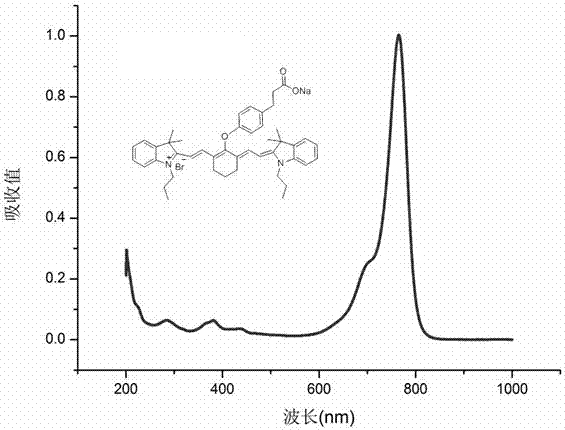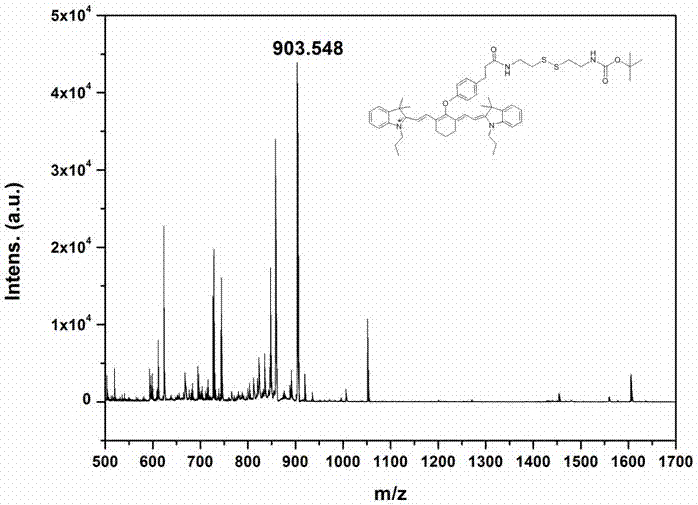Near infrared fluorescent dye taking fluorophore of cyanine dye as parent skeleton structure and preparation method and application thereof
A technology of fluorescent groups and fluorescent dyes, which is applied in the field of near-infrared fluorescent dyes and their preparation, can solve the problems of rare, viral carrier limitations, and low transfection efficiency, and achieve improved photostability, high yield, The effect of high fluorescence intensity
- Summary
- Abstract
- Description
- Claims
- Application Information
AI Technical Summary
Problems solved by technology
Method used
Image
Examples
Embodiment 1
[0053] Preparation of near-infrared fluorescent dyes with cyanine dye fluorescent groups as the parent skeleton structure
[0054] (1) The synthetic route of compound 1 is as follows:
[0055]
[0056] Specific steps: In a 100 mL sealed tube, dissolve 10 g (63 mmol, 1 eq) of 2,3,3-trimethylindole in 30 mL of toluene, and then add 7.72 g (63 mmol, 1 eq) of 1- bromopropane. React at 130°C for 72 h, after cooling, let it stand for a while, and pour off the upper layer solution. The red solid in the lower layer was washed twice with ether, spin-dried, and weighed to obtain 15 g of compound 1 with a yield of 84.7%, which was sealed and stored in a -20°C refrigerator.
[0057] (2) The synthetic route of compound 2 is as follows:
[0058]
[0059] Specific steps: In a 250 mL round bottom flask, mix 40 mL of DMF and 20 mL of dichloromethane in an ice-water bath, then add the mixture of 20 mL of dichloromethane and 37 mL of phosphorus oxychloride dropwise into the above soluti...
Embodiment 2
[0070] Preparation of Linker Molecules Containing Reduction Sensitive Bonds
[0071] The synthetic route of compound 6 is as follows:
[0072]
[0073] Specific steps: In a 1 L round bottom flask, dissolve 8 g (35 mmol, 1 eq) of cystamine dihydrochloride in 300 mL of methanol, and then add 7.07 g (70 mmol, 2 eq) of triethylamine. Then dissolve 6.7 g (31 mmol, 0.88eq) of di-tert-butyl dicarbonate in 200 mL of methanol, under stirring, in an ice-water bath, slowly drop the methanol solution of di-tert-butyl dicarbonate into cystamine di Hydrochloride in methanol solution. React overnight at 30°C, then use a rotary evaporator to spin off the methanol, and add 100 mL of dichloromethane to redissolve. Wash twice with 50 mL of saturated NaCl solution, dry with anhydrous sodium sulfate, filter with suction, and spin dry. Weighed to obtain 7.2 g of crude product, the crude yield was 92.3%. Purify with a silica gel column, using dichloromethane / methanol system as eluent, and iso...
Embodiment 3
[0075] Preparation of Second Generation Lysine-Arginine Dendrimers
[0076] (1) The synthetic route of compound 7 is as follows:
[0077]
[0078] Specific steps: Boc-Arg(Pbf)-OH 11.3 g (21.45mmol, 2.5 eq) and benzotriazole-N,N,N',N'-tetramethyluronium hexafluorophosphate (HBTU) 9.76 g (25.74mmol, 3eq) were dissolved in 20 mL N,N-dimethylformamide (DMF), mixed in a 250 mL round bottom flask, and N,N-diisopropylethylamine (DIEA) was added 3.33 g (25.74mmol, 3eq) were reacted for a while. Dissolve 2 g (8.58 mmol, 1 eq) of L-lysine methyl ester hydrochloride in 20 mL DMF, and add it dropwise to the above reaction solution while stirring. 30°C, N 2 Reacted for 48 h under protection. After the reaction, use a rotary evaporator to spin off the DMF, and add 200 mL of dichloromethane to redissolve. With 100 mL saturated sodium bicarbonate (NaHCO 3 ), 100 mL saturated sodium dihydrogen phosphate (NaH 2 PO 4 ) and 100 mL of saturated sodium chloride solution (NaCl) were washe...
PUM
 Login to View More
Login to View More Abstract
Description
Claims
Application Information
 Login to View More
Login to View More - R&D
- Intellectual Property
- Life Sciences
- Materials
- Tech Scout
- Unparalleled Data Quality
- Higher Quality Content
- 60% Fewer Hallucinations
Browse by: Latest US Patents, China's latest patents, Technical Efficacy Thesaurus, Application Domain, Technology Topic, Popular Technical Reports.
© 2025 PatSnap. All rights reserved.Legal|Privacy policy|Modern Slavery Act Transparency Statement|Sitemap|About US| Contact US: help@patsnap.com



